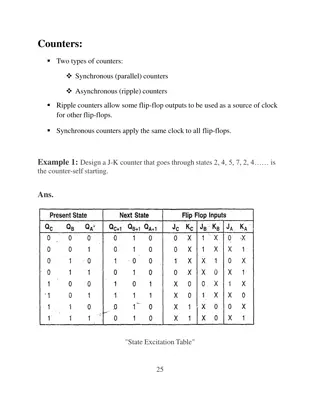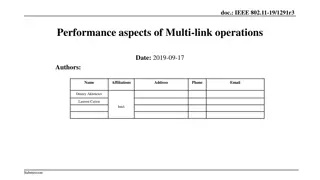
Async Programming Review & Implications
Explore asynchronous programming concepts in JavaScript/TypeScript, understand the use of Promises with axios library for HTTP requests, and review the outcomes when making multiple asynchronous requests. Delve into the implications of run-to-completion in asynchronous programming.
Download Presentation

Please find below an Image/Link to download the presentation.
The content on the website is provided AS IS for your information and personal use only. It may not be sold, licensed, or shared on other websites without obtaining consent from the author. If you encounter any issues during the download, it is possible that the publisher has removed the file from their server.
You are allowed to download the files provided on this website for personal or commercial use, subject to the condition that they are used lawfully. All files are the property of their respective owners.
The content on the website is provided AS IS for your information and personal use only. It may not be sold, licensed, or shared on other websites without obtaining consent from the author.
E N D
Presentation Transcript
CS 4530 Software Engineering Lecture 7 - Asynchronous Programming II Jonathan Bell, John Boyland, Mitch Wand Khoury College of Computer Sciences
Zoom Mechanics Recording: This meeting is being recorded If you feel comfortable having your camera on, please do so! If not: a photo? I can see the zoom chat while lecturing, slack while you re in breakout rooms If you have a question or comment, please either: Raise hand - I will call on you Write Q: <my question> in chat - I will answer your question, and might mention your name and ask you a follow-up to make sure your question is addressed Write SQ: <my question> in chat - I will answer your question, and not mention your name or expect you to respond verbally
Todays Agenda Administrative: Team formation due Friday HW2 posted, due next Friday HW1 solution posted on Piazza Today s session: Review: Asynchronous Programming Activity: Asynchronous Programming
Review: Asynchronous Programming in JS/TS Promises axios.get returns a Promise for an AxiosResponse console.log('Making a request to rest-example'); axios.get('https://rest-example.covey.town/') // axios is a popular library for making HTTP requests .then((response) =>{ console.log('Heard back from server'); console.log(response.data); }); console.log('Response sent!'); Promise.then will run the event handler provided once the value that is promised becomes available Output: Making a request to rest-example Response sent! Heard back from server This is GET number 4 on the current server axios.get is an asynchronous call
Review: Making lots of requests 3 Requests: What is the output? These 2 lines ALWAYS first (same handler) console.log('Making a requests'); axios.get('https://rest-example.covey.town/') .then((response) =>{ console.log('Heard back from server'); console.log(response.data); }); axios.get('https://www.google.com/') .then((response) =>{ console.log('Heard back from Google'); }); axios.get('https://www.facebook.com/') .then((response) =>{ console.log('Heard back from Facebook'); }); console.log('Requests sent!'); Sample Output: Making a requests Requests sent! Heard back from Google Heard back from server This is GET number 6 on the current server Heard back from Facebook These 2 lines ALWAYS together (same handler) No guarantee on order of hearing back from Google, our server, or Facebook (new handlers)
Review: Implications of run-to-completion Run-to-completion: first 2 lines ALWAYS first, covey.town handler lines always together These 2 lines ALWAYS first (same handler) console.log('Making a requests'); axios.get('https://rest-example.covey.town/') .then((response) =>{ console.log('Heard back from server'); console.log(response.data); }); axios.get('https://www.google.com/') .then((response) =>{ console.log('Heard back from Google'); }); axios.get('https://www.facebook.com/') .then((response) =>{ console.log('Heard back from Facebook'); }); console.log('Requests sent!'); Sample Output: Making a requests Requests sent! Heard back from Google Heard back from server This is GET number 6 on the current server Heard back from Facebook These 2 lines ALWAYS together (same handler) No guarantee on order of hearing back from Google, our server, or Facebook (new handlers)
Review: What NOT to do in an event handler? Run-to-completion: Slow handlers are really bad. axios.get('https://rest-example.covey.town/') .then((response) =>{ console.log('Heard back from server'); console.log(response.data); }); axios.get('https://www.google.com/') .then((response) =>{ console.log('Heard back from Google'); fs.writeFileSync("google-response.txt",response.data); }); axios.get('https://www.facebook.com/') .then((response) =>{ console.log('Heard back from Facebook'); fs.writeFileSync("facebook-response.txt",response.data); }); axios.get('https://rest-example.covey.town/') .then((response) =>{ console.log('Heard back from server'); console.log(response.data); }); axios.get('https://www.google.com/') .then((response) =>{ console.log('Heard back from Google'); return fsPromises.writeFile("google-response.txt",response.data); }); axios.get('https://www.facebook.com/') .then((response) =>{ console.log('Heard back from Facebook'); return fsPromises.writeFile("facebook-response.txt",response.data); }); 3 seconds 2.1 seconds Write a file synchronously (write it in this event handler) Write a file asynchronously (Ask NodeJS to write it in the background, this returns a new Promise to tell us when it s done) Good news: You usually have to go out of your way to use synchronous I/O in NodeJS (the methods all have the word Sync in them)
Review: Async/Await Your asynchronous friend Rules of the road: You can only call await from a function that is async You can only await on functions that return a Promise Beware: await makes your code synchronous (this is what we want it for)! Handle errors using try/catch axios.get('https://rest-example.covey.town/').then(response => { console.log('Heard back from server'); console.log(response.data); }).catch(err => { console.log("Uh oh!"); console.trace(err); }); async function axiosAwaitExample() { try{ const response = await axios.get('https://rest-example.covey.town/') console.log('Heard back from server'); console.log(response.data); } catch(err){ console.log("Uh oh!"); console.trace(err); } }
Review: Example: Writing Asynchronous Tasks Transcript Server: Calculating statistics (async/await vs Promise) function runClientPromises() { console.log('Making a requests'); const studentIDs = [1, 2, 3, 4]; const promisesForTranscripts = studentIDs.map( studentID => axios.get(`https://rest-example.covey.town/transcripts/${studentID}`) .then((response) => fsPromises.writeFile(`transcript-${response.data.student.studentID}.json`, JSON.stringify(response.data)) )); return Promise.all(promisesForTranscripts).then(results => { const statsPromises = studentIDs.map(studentID => fsPromises.stat(`transcript-${studentID}.json`)); return Promise.all(statsPromises).then(stats => { const totalSize = stats.reduce((runningTotal, val) => runningTotal + val.size, 0); console.log(`Finished calculating size: ${totalSize}`); }); }).then(() => { console.log('Done'); }); console.log('Requests sent!'); } async function runClientAsync() { console.log('Making a requests'); const studentIDs = [1, 2, 3, 4]; const promisesForTranscripts = studentIDs.map( async (studentID) => { const response = await axios.get(`https://rest-example.covey.town/transcripts/${studentID}`) await fsPromises.writeFile(`transcript-${response.data.student.studentID}.json`, JSON.stringify(response.data)) }); console.log('Requests sent!'); await Promise.all(promisesForTranscripts); const stats = await Promise.all(studentIDs.map(studentID => fsPromises.stat(`transcript-${studentID}.json`))); const totalSize = stats.reduce((runningTotal, val) => runningTotal + val.size, 0); console.log(`Finished calculating size: ${totalSize}`); console.log('Done'); }
New example: A bad handler For large values of count, this is very slow! function approximatePi(count) { let inside = 0; const r = 5; console.log(`Approximating Pi using ${count} iterations`) for (let i = 0; i < count; i++) { const x = Math.random() * r * 2 - r; const y = Math.random() * r * 2 - r; if ((x * x + y * y) < r * r) { inside++ } } const ret = 4.0 * inside / count; console.log(`Computed: ${ret}`); return ret; }
Review: Async/Await gone mad Where you place awaits can make a big difference! The code we ve seen on past slides: For each student: make an async handler to fetch their transcript and save it async function runClientAsync() { console.log('Making a requests'); const studentIDs = [1, 2, 3, 4]; const promisesForTranscripts = studentIDs.map( async (studentID) => { const response = await axios.get(`https://rest-example.covey.town/transcripts/${studentID}`) await fsPromises.writeFile(`transcript-${response.data.student.studentID}.json`, JSON.stringify(response.data)) }); console.log('Requests sent!'); await Promise.all(promisesForTranscripts); const stats = await Promise.all(studentIDs.map(studentID => fsPromises.stat(`transcript-${studentID}.json`))); const totalSize = stats.reduce((runningTotal, val) => runningTotal + val.size, 0); console.log(`Finished calculating size: ${totalSize}`); } For each student: wait to fetch their transcript, then wait to write it, then go on to the next student Running time: 1.5 sec This does something different: async function runClientAsyncSerially() { console.log('Making a requests'); const studentIDs = [1, 2, 3, 4]; for(let studentID of studentIDs){ const response = await axios.get(`https://rest-example.covey.town/transcripts/${studentID}`); await fsPromises.writeFile(`transcript-${response.data.student.studentID}.json`, JSON.stringify(response.data)) } let totalSize = 0; for(let studentID of studentIDs){ const stats = await fsPromises.stat(`transcript-${studentID}.json`); totalSize += stats.size; } console.log(`Finished calculating size: ${totalSize}`); } Running time: 2.2 sec This is what we mean by your code can become synchronous
Review: Async/Await Programming Activity Transcript Server: Create a student, then update their 1.Create a new student in the transcript server axios.post('https://rest-example.covey.town/transcripts', {name: Breakout Group 0 }) then 2.Assign several grades for that student axios.post(`https://rest-example.covey.town/transcripts/${studentID}/${course}`,{grade: theGrade})) then 3.Fetch the transcript for that student axios.get(`https://rest-example.covey.town/transcripts/${studentID}`) If you finish with time to spare, try to make different variants: make a lot of requests concurrently vs making the requests synchronously (waiting between each request)
Scheduling Asynchronous Tasks: Timers Call this function after the timer expires Call this function each time the timer fires setTimeout(()=>{ setInterval( ()=>{ console.log("Boom!"); }, 1000); console.log('Tick!'); } ,100); Timer goes off after 1,000 msec Fire ever 100 msec const timedBoom = setTimeout(()=>{ console.log("Boom!"); }, 1000); clearInterval(timedBoom) // Defuse Bomb const ticker = setInterval(()=>{ console.log('Tick!'); },100); clearInterval(ticker) // Cancel timer
Writing our own Promises Call this function to resolve the promise (whatever you pass to resolve gets passed to then ) function timedPromise(): Promise<number> { return new Promise<number>((resolve, reject) => { const random = Math.random(); if (random < 0.5) setTimeout(() => { reject(random); }, 1000); else setTimeout(() => { resolve(random); }, 1000); }); } timedPromise().then((val)=>{ console.log(`Promise succeeded with ${val}`) }).catch(val =>{ console.error(`Promise failed with ${val}`) }) Call this function to reject the promise (whatever you pass to reject gets passed to catch ) No matter how many times the .then is called, this code runs only once: when the Promise is created. Once resolve or reject is called, the value of the promise is locked-in
Asynchronous activity Download this: https://neu-se.github.io/CS4530-CS5500-Spring- 2021/Examples/Example%204.0%20transcript-server-client.zip Instructions in README.md (zip is updated from Monday, if you downloaded previously, please re-download)
This work is licensed under a Creative Commons Attribution-ShareAlike license This work is licensed under the Creative Commons Attribution-ShareAlike 4.0 International License. To view a copy of this license, visit http://creativecommons.org/licenses/by-sa/4.0/ You are free to: Share copy and redistribute the material in any medium or format Adapt remix, transform, and build upon the material for any purpose, even commercially. Under the following terms: Attribution You must give appropriate credit, provide a link to the license, and indicate if changes were made. You may do so in any reasonable manner, but not in any way that suggests the licensor endorses you or your use. ShareAlike If you remix, transform, or build upon the material, you must distribute your contributions under the same license as the original. No additional restrictions You may not apply legal terms or technological measures that legally restrict others from doing anything the license permits.






















